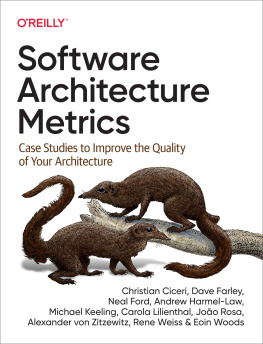Diomidis Spinellis - Beautiful Architecture: Leading Thinkers Reveal the Hidden Beauty in Software Design
Here you can read online Diomidis Spinellis - Beautiful Architecture: Leading Thinkers Reveal the Hidden Beauty in Software Design full text of the book (entire story) in english for free. Download pdf and epub, get meaning, cover and reviews about this ebook. year: 2009, publisher: OReilly Media, genre: Computer. Description of the work, (preface) as well as reviews are available. Best literature library LitArk.com created for fans of good reading and offers a wide selection of genres:
Romance novel
Science fiction
Adventure
Detective
Science
History
Home and family
Prose
Art
Politics
Computer
Non-fiction
Religion
Business
Children
Humor
Choose a favorite category and find really read worthwhile books. Enjoy immersion in the world of imagination, feel the emotions of the characters or learn something new for yourself, make an fascinating discovery.

- Book:Beautiful Architecture: Leading Thinkers Reveal the Hidden Beauty in Software Design
- Author:
- Publisher:OReilly Media
- Genre:
- Year:2009
- Rating:3 / 5
- Favourites:Add to favourites
- Your mark:
Beautiful Architecture: Leading Thinkers Reveal the Hidden Beauty in Software Design: summary, description and annotation
We offer to read an annotation, description, summary or preface (depends on what the author of the book "Beautiful Architecture: Leading Thinkers Reveal the Hidden Beauty in Software Design" wrote himself). If you haven't found the necessary information about the book — write in the comments, we will try to find it.
What are the ingredients of robust, elegant, flexible, and maintainable software architecture? Beautiful Architecture answers this question through a collection of intriguing essays from more than a dozen of todays leading software designers and architects. In each essay, contributors present a notable software architecture, and analyze what makes it innovative and ideal for its purpose.
Some of the engineers in this book reveal how they developed a specific project, including decisions they faced and tradeoffs they made. Others take a step back to investigate how certain architectural aspects have influenced computing as a whole. With this book, youll discover:
- How Facebooks architecture is the basis for a data-centric application ecosystem
- The effect of Xens well-designed architecture on the way operating systems evolve
- How community processes within the KDE project help software architectures evolve from rough sketches to beautiful systems
- How creeping featurism has helped GNU Emacs gain unanticipated functionality
- The magic behind the Jikes RVM self-optimizable, self-hosting runtime
- Design choices and building blocks that made Tandem the choice platform in high-availability environments for over two decades
- Differences and similarities between object-oriented and functional architectural views
- How architectures can affect the softwares evolution and the developers engagement
Go behind the scenes to learn what it takes to design elegant software architecture, and how it can shape the way you approach your own projects, with Beautiful Architecture.
Diomidis Spinellis: author's other books
Who wrote Beautiful Architecture: Leading Thinkers Reveal the Hidden Beauty in Software Design? Find out the surname, the name of the author of the book and a list of all author's works by series.









